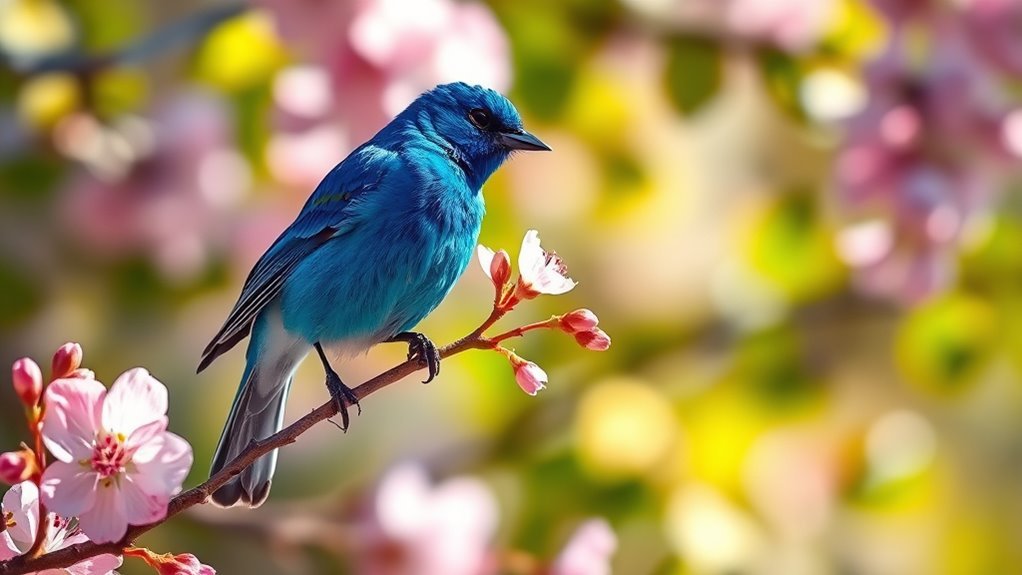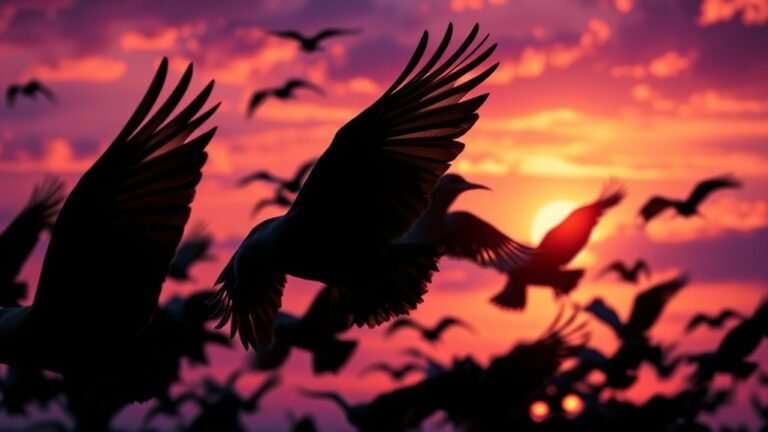Seeing Blue Birds: What Is Its Significance?
Seeing a blue bird can hold significant meaning in various cultures. These colorful birds represent themes of freedom, joy, and hope. They invite you to think about your emotions. Blue birds often symbolize renewal, encouraging a deeper understanding of yourself. Reflect on how these ideas relate to your life as you explore the meanings associated with blue birds.
Key Takeaways
- Seeing blue birds symbolizes freedom, happiness, and the pursuit of one's dreams, encouraging personal exploration and joy.
- In various cultures, blue birds are seen as messengers of good fortune and renewal, bringing hope and inspiration.
- The blue color of these birds represents clarity and calmness, suggesting moments of inner peace and connection to the universe.
- Observing blue birds can significantly uplift mood and alleviate feelings of anxiety and sadness, promoting emotional well-being.
- They embody aspirations and the soul's yearning for a better life, serving as powerful symbols in literature and art.
The Symbolism of Blue Birds in Various Cultures

Blue birds appear in many cultures around the world, each holding different meanings. Generally, they symbolize freedom and happiness. Their bright blue color is often linked to the sky and wide-open spaces.
In Native American mythology, blue birds signify purity and renewal. They're seen as messengers from the spirit world.
In some Asian cultures, blue birds represent love and loyalty, highlighting the importance of strong relationships.
The various interpretations of blue birds create a rich tapestry of meaning. Understanding these symbols can deepen your connection to themes of hope, love, and transformation found in blue bird mythology. This makes these beautiful creatures even more fascinating.
A Glimpse Into Blue Bird Folklore
Blue birds have fascinated storytellers and communities throughout history. These beautiful creatures symbolize hope, happiness, and renewal in many cultures. Their bright color often represents divine protection and guidance, linking us to nature.
In Native American folklore, blue birds are seen as messengers of good fortune, bringing joy and a sense of community.
In European stories, blue birds symbolize the search for happiness, encouraging people to embark on their journeys.
Understanding these tales helps us appreciate blue birds more. They connect us through shared stories of wonder and optimism.
Join in exploring these narratives that inspire us all.
The Spiritual Meaning Behind Blue Birds

Blue birds are significant in many spiritual traditions. Seeing a blue bird can mean you're receiving spiritual guidance. This is a call to explore your path with purpose.
The blue color represents clarity and calmness, helping you find inner peace. This connection can remind you that you belong to a larger universe, and you aren't alone.
When a blue bird appears, pay attention to your thoughts and feelings; they may lead to personal growth and understanding. Welcome these moments as chances to connect with your higher self and support your spirit.
Blue Birds as Messengers of Joy
When you see a blue bird, it represents joy and happiness. This bird encourages you to embrace the bright side of life. Its colorful feathers and sweet songs can lift your mood and help you notice the beauty in everyday moments.
If you spot a blue bird, take a moment to think about its message. It might inspire you to connect with others and share happiness.
Hope and Renewal: The Message of the Blue Bird

Many people see blue birds as symbols of joy, but they also represent hope and renewal. They encourage you to recognize the chance for new beginnings.
The message of blue birds shows that even in tough times, you can embrace change and grow. Watching these beautiful creatures helps you feel connected to a larger community of those wanting transformation.
Their bright feathers remind you that beauty often comes after hardship, showing that each new day can bring renewal. Their songs provide support, encouraging you to let go of the past and welcome new opportunities.
Let the spirit of the blue bird inspire your journey of renewal and connection.
Blue Birds in Literature and Art
Blue birds have fascinated writers and artists throughout history. They symbolize beauty, hope, and freedom.
In literature, blue birds often represent the soul's yearning for a better life. In poetry, they embody the aspirations we all hold. In art, blue birds appear in vibrant paintings, where their colors bring joy and evoke deep emotions.
These works connect with our desire for belonging and freedom. Blue birds remind us of our dreams and the pursuit of happiness. Their presence enriches both literature and art, showcasing their lasting impact on our cultural landscape.
The Connection Between Blue Birds and Personal Growth
Blue birds symbolize personal growth. Their bright blue color represents clarity and inspiration.
When you see a blue bird, it encourages you to embrace change and find inner peace amid life's challenges. This moment reminds you that growth involves both successes and setbacks.
By connecting with blue birds, you can see the beauty in your struggles and the strength they bring. These encounters encourage you to build community and understanding, enhancing your personal development.
Appreciate the journey and the connections that support your growth.
Observing Blue Birds: A Call to Mindfulness
Observing blue birds offers more than just a glimpse of their bright colors; it's a practice of mindfulness.
This activity connects you with nature and creates a feeling of belonging in a busy world. As you watch their wings flutter and hear their cheerful chirps, you block out distractions. You become aware of the life around you.
Each sighting serves as a reminder of the calm nature can provide. This encourages you to stop, think, and enjoy the present.
The Role of Blue Birds in Nature Conservation
Blue birds are admired for their striking colors, but their importance in nature conservation is significant.
These birds help indicate the health of their ecosystems. When you see a blue bird, it shows that the environment supports many plants and animals, which promotes biodiversity.
Blue birds also play a key role in controlling pests and pollinating flowers. This helps maintain balanced ecosystems.
You can support blue birds by getting involved in local conservation efforts. Protecting these birds also protects their habitats, benefiting the entire ecosystem.
This responsibility connects you to a broader environmental cause, fostering a community spirit while preserving nature.
How Blue Birds Reflect Our Emotions
Blue birds often fly gracefully in the sky. Their bright colors represent peace, connection, and happiness. These feelings connect to color psychology. When you see a blue bird, it may remind you of calm and warm memories. The soothing blue color gives a sense of stability.
This can lead you to think about feelings of belonging and community. In your life, blue birds can remind you of joy and hope. They encourage you to accept your emotions. This connection can help you appreciate your feelings more.
You might also notice how color affects your emotional experiences and your interactions with others.
The Impact of Blue Birds on Mental Health
Blue birds can positively impact mental health. When you see these bright birds, they can lift your mood and create feelings of happiness. Blue birds represent hope and peace, helping people feel strong emotionally.
Observing blue birds or looking for them can improve your well-being. When you appreciate their beauty, you may feel more relaxed, reducing anxiety and sadness. Their presence reminds you to enjoy simple joys in life and can help you feel more connected to nature.
Ways to Attract and Appreciate Blue Birds in Your Environment
To attract blue birds to your area, create a friendly space for them. Start by adding blue bird feeders. Fill these with suet, mealworms, or specific seed mixes. Plant bird-friendly options like dogwoods and berry bushes in your garden to provide natural nesting spots.
Keep feeders clean and filled, and note seasonal changes to spot peak bird activity.
Take time to watch the birds in your backyard. This helps you appreciate their beauty. Share your birdwatching ideas with friends who enjoy it too. Capture photos of the blue birds to highlight their vibrant colors.
Support local conservation efforts to protect their habitats. This helps blue birds thrive and improves your outdoor space. Their presence can bring joy and a feeling of connection to nature.
Frequently Asked Questions
What Species of Blue Birds Are Most Common in North America?
In North America, blue jays and eastern bluebirds are common. Blue jays are known for their loud calls and intelligence. They often gather in groups and can be seen visiting bird feeders. Eastern bluebirds prefer open fields and woodlands. They hunt for insects and fruits near the ground. Both species build nests and care for their young, making them a delight to observe in nature. Their vibrant blue color adds beauty to the landscape.
How Can I Differentiate Between Similar-Looking Blue Bird Species?
To tell similar-looking blue bird species apart, focus on their colors and behaviors. Look for slight differences in their shades or markings. Listen to their calls and watch their flight patterns; these details help identify each species clearly. Enjoy the process of observing these beautiful birds, and you'll become better at distinguishing between them.
What Do Blue Bird Songs Sound Like?
Blue bird songs are beautiful and melodic. They feature sounds that can range from sweet trills to varied phrases. Each species of blue bird has its own unique sound. These songs create a delightful atmosphere and invite listeners to engage with nature.
Are Blue Birds Endangered or Threatened?
Blue birds are not classified as endangered. However, they face threats due to habitat loss. Conservation efforts aim to protect their habitats and ensure these beautiful birds can thrive in the wild. By preserving the areas where they live, we can help support their populations and enjoy their presence for years to come.
What Time of Year Do Blue Birds Typically Migrate?
Bluebirds migrate in spring and fall. In spring, they travel north to breed. In fall, they move south for winter. You can see their bright colors during these seasonal journeys, adding beauty to the changing landscape.

Hello, I’m Emily Price, the founder of Birds Affection. As a passionate bird enthusiast and spiritual seeker, I’ve always been fascinated by the symbolic meanings and mystical connections between birds and our lives. On this website, I share my knowledge and insights on the spiritual significance of various bird species, exploring their roles as messengers, guides, and teachers. Through my writing, I aim to inspire and educate others on the profound wisdom and beauty that birds bring to our world. Join me on this journey as we delve into the enchanting realm of bird symbolism and discover the hidden meanings behind these magnificent creatures.







